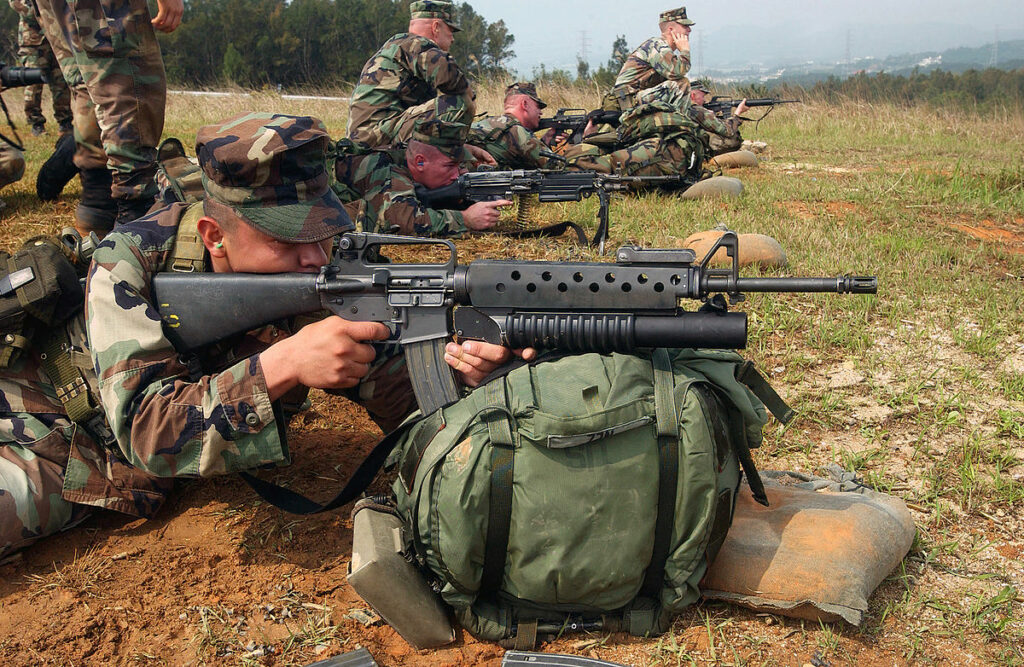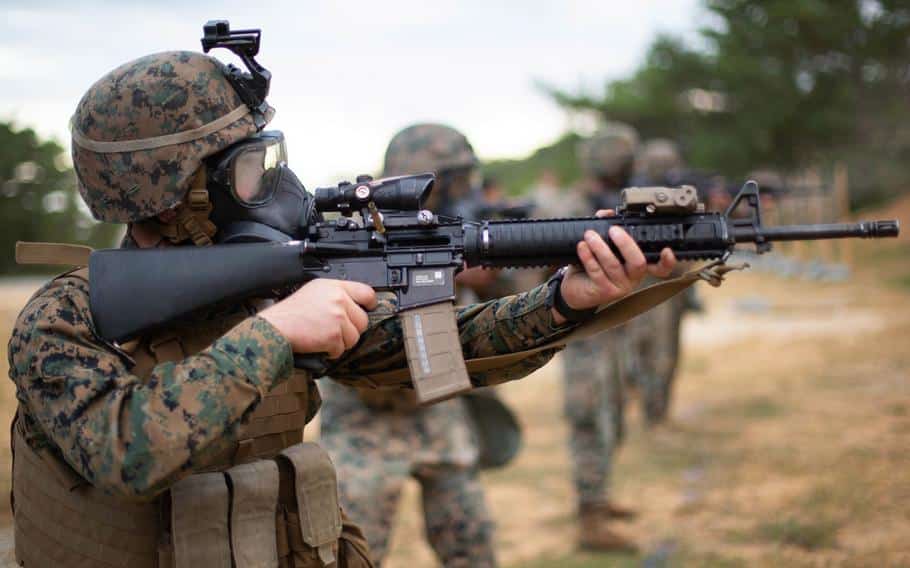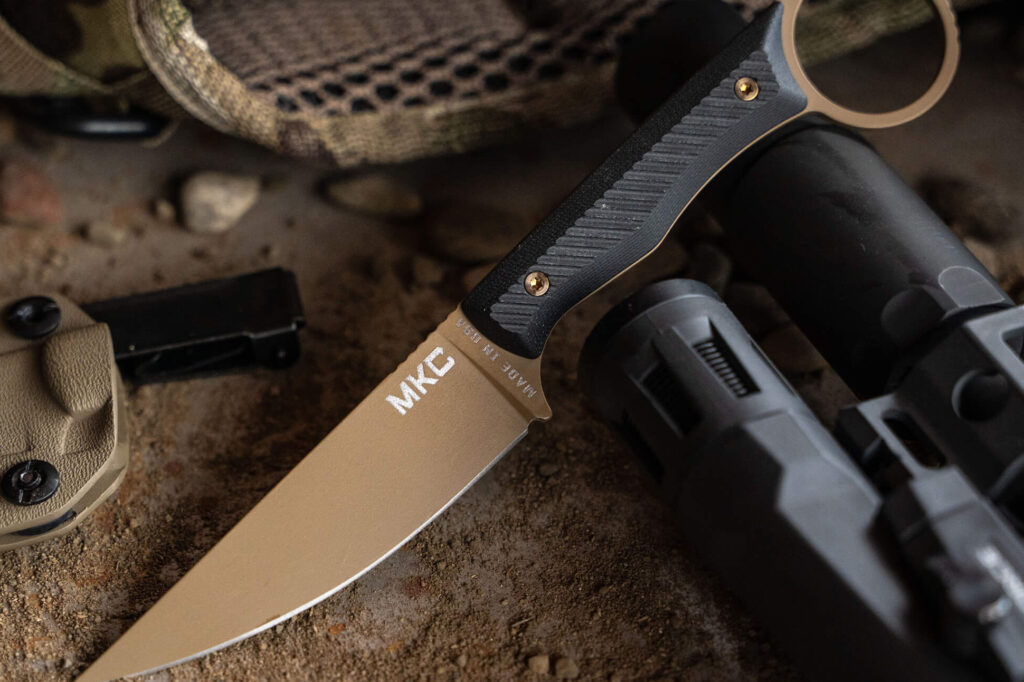What is a carry handle and why do rifles have them?
- By Travis Pike
Share This Article

What do purses, suitcases, and automatic rifles have in common? They all have carry handles! Or well, a lot of them do. A carry handle on a firearm isn’t super uncommon. Lots of guns have them from the M16 to the M240 machine gun have them. These carry handles seem somewhat odd on your normal infantry rifle.
Machine guns weigh tens of pounds and their handles are often situated on the barrels. Barrels get nice and hot, so the handle makes it easy to pop the barrel off and change it with relative ease. So why did Eugene Stoner place a carry handle on his AR 10 and later AR 15 design? That’s the question we aim to answer today, and along the way, we’ll also answer why most guns have these handles.
What is a carry handle?

That thing sits on top of early to not that long ago M16 models — specifically the original M16, the M16A1, and M16A2. Weapons like the G36 and VHS also have carry handles. Those big, somewhat obnoxious oblong things sit on the top of the rifle’s receiver.
However, even though they’re called carry handles, I would never suggest carrying a rifle by the carry handle. Not because it would damage the weapon somehow, but because some NCO would come out of the woodline and rip your soul from your body. Even though it’s called a carry handle, in modern tactical environments it’s a major faux pas to use it as such.
Related: The Marine Corps has a weapon maintenance problem
Why do they exist?

We’ve established that you certainly can’t use one to carry your rifle. Then why? Why did the M16 have a carry handle and seemingly abandon it with the A3/A4 variants and all modern carbines?
Let’s start with the original M16 design. That early AR 15 and AR 10 design featured a charging handle placed on the receiver. It looks a bit like a trigger, but that’s how the weapon was designed to be readied. The carry handle protected this exposed charging handle.
By the time the AR 15 became the M16, the rifle ditched the top-mounted charging handle for the rear-mounted model we all know and love today. Yet, the charging handle remained in existence.
Related: Breaking down the Nairobi rifle of SAS Christian Craighead
Looking through the sights
If you look at the design of the AR 15, notice how the barrel lines up perfectly with the stock. This in-line design makes a huge difference in how you aim the weapon. The sights must sit higher due to the in-line design. On the M16, the sights sit inside the carry handle. That extra height is required to ensure the sights can be properly used.
If they were lower, it would be near impossible to establish a good cheek weld. That in-line design of the rifle serves a purpose. It helps make the rifle more controllable and allows the user to effectively mitigate recoil and muzzle rise.

This is why almost all guns with carry handles have them. Examine the AK for a second. Notice how much lower the stock is than the barrel. This design allows the iron sights to sit lower and disregards the need for a carry handle.
These days the M16A3/M16A4, the M4, Mk 18, etc., all have a flat-top upper receiver. This flat-top upper receiver has a Picatinny rail and a universal mounting system for attaching accessories to a weapon. Accessories, including optics, now dominate the modern firearm world.

These optics have to be a specific height to be used, and that height is often the same or close to that of a handle.
The time of carry handles is ending
While carry handles on rifles serve a distinct purpose, they are largely disappearing from the firearms world.
Although they tend to stick around on machine guns, from rifles, they are disappearing almost entirely. It’s a sad day to see the goofy little carry disappear, but that’s how the world spins.
Read more from Sandboxx News
Related Posts
Sandboxx News Merch
-

A-10 ‘Warthog’ Poster
$22.00 – $28.00 Select options This product has multiple variants. The options may be chosen on the product page -

F-35 ‘Lightning’ Framed Poster
$45.00 – $111.00 Select options This product has multiple variants. The options may be chosen on the product page -

A-10 ‘Thunderbolt Power’ Poster
$22.00 – $28.00 Select options This product has multiple variants. The options may be chosen on the product page

Travis Pike
Travis Pike is a former Marine Machine gunner who served with 2nd Bn 2nd Marines for 5 years. He deployed in 2009 to Afghanistan and again in 2011 with the 22nd MEU(SOC) during a record-setting 11 months at sea. He’s trained with the Romanian Army, the Spanish Marines, the Emirate Marines, and the Afghan National Army. He serves as an NRA certified pistol instructor and teaches concealed carry classes.
Related to: Gear & Tech

No, Russia’s futuristic Sotnik armor isn’t real

What does a Marine veteran think of Netflix’s ‘Rebel Ridge’?

Montana Knife Company enters the tactical knife realm

Indonesia’s Pindad SS2 – Service rifles from around the world
Sandboxx News
-

‘Sandboxx News’ Trucker Cap
$27.00 Select options This product has multiple variants. The options may be chosen on the product page -

‘AirPower’ Classic Hoodie
$46.00 – $48.00 Select options This product has multiple variants. The options may be chosen on the product page -

‘AirPower’ Golf Rope Hat
$31.00 Select options This product has multiple variants. The options may be chosen on the product page -

‘Sandboxx News’ Dad Hat
$27.00 Select options This product has multiple variants. The options may be chosen on the product page
